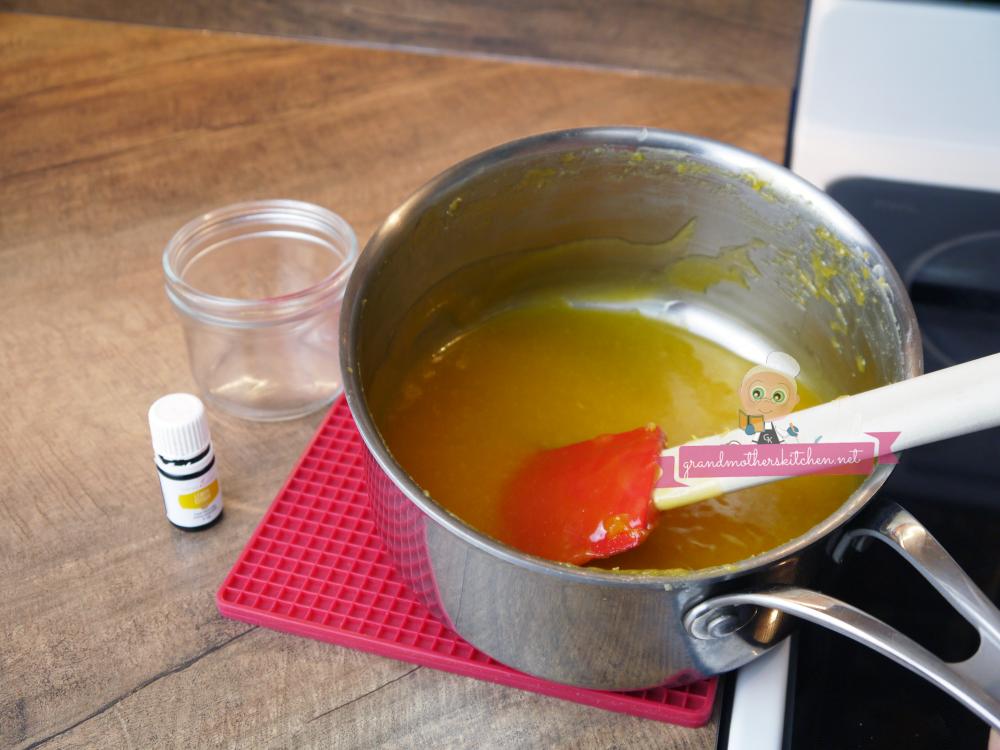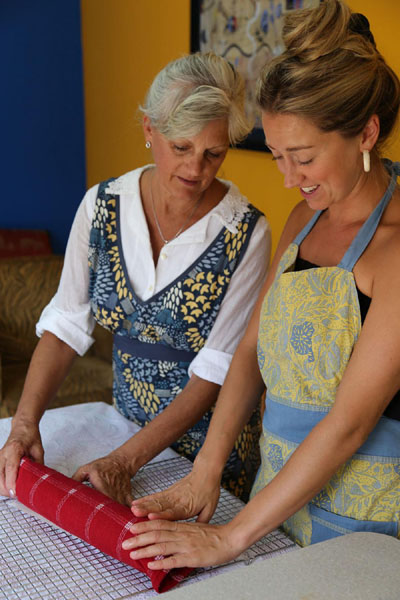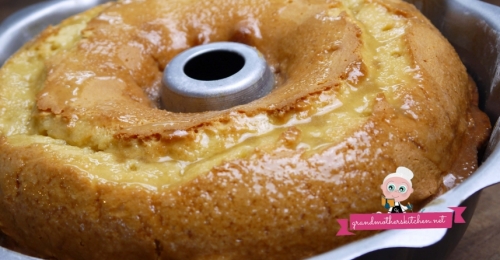Classic Lemon Curd

About this Recipe
The lemon curd recipe we made in this recipe has a very dark yellow-orange color. In fact, it shows the color in its truth and is based on the color of the egg yolks we are baking with. It is a commonly held belief in our family that deep rich yellow/orange eggs are more nutritious than pale yellow eggs but simply that belief is not based on fact. The various colors of egg yolks can mean a couple of things.
First, the color of the eggs will change depending on the hen's diet. In general, the more carotenoids – naturally occurring red and orange pigments found in a variety of plants and animals – the hen eats, the brighter and darker the yolk will be. Also many farmers work with a company called YolkFan, which is sort of a like a painting palette for egg farmers that has 15 different shades of yellow.(1) It contains synthetic carotenoids, and farmers can add this to their chicken feed to get the exact egg yolk color that they prefer. (Of interest - salmon farmers also have a palette to add coloring to salmon to make it more appealing.)
Why would farmers do this at all you ask? Why not simply allow the eggs to be natural? Well it all comes down to marketing. Yep. Humans base A LOT of their food choices and preferences on the color of the food before it even hits their lips.
When I was studying nutrition in University, we had a sensory evaluation course where we rated the sourness of different candy of different colors. Most of us found the yellow and orange to be more sour, and were later shocked to find that the level of sourness was exactly the same for all the colors, but our brain perceived them as different. Pretty fascinating stuff! This is why food has color added to it, is because humans gravitate towards certain colors of food more than others. Bright and vibrant seem to be important. But of course adding color to food is not so good.
What is also interesting about egg color is that the desirability of different colors varies from country to country. Canadians prefer a lemon yellow egg, while in Japan, a darker orange, almost red egg is the most desirable. So all in all - if you can get to know your chicken farmer, why not ask them their practices? Do they add a synthetic color agent, or do they just feed their hens more red and yellow foods that are naturally high in carotenoids?
Grandmother's TIPS for How to Make Lemon Curd:
1. This recipe below is a wonderful way to make curd. If you check other methods they are a little more complex. This is a
fool-proof method. Creaming the ingredients ahead of time before heating will give you that 'uncurdled' satiny curd that is perfect in other desserts.
2. It took us 7 small lemons to get 2/3 cup juice: the size and amount of juice in lemon will vary the amount of how many you will need. Often you will get that from 2 nice big lemons, and you never know how juicy you lemons are going to be.
3. If you do not want to squeeze your own juice you could also use bottled Pure Lemon Juice.
4. Choose organic lemons if you are using them for zests and salad dressings. Often small firm lemons give you more juice but you never know for sure. Even with organic you want to wash the lemons well before using them. Choose the smooth skinned lemons and the thinner feeling peel ones for higher nutritional value.
5. Some recipes using this lemon curd include: Grandmother's Lemon Thumbprint Cookies and Lemon Chocolate Shortbread Squares.
Ingredients
Makes: About 2 cups
3 ounces (6 Tablespoons) unsalted butter at room temperature
1 cup granulated sugar
2/3 cup fresh lemon juice , it took us 7 small lemons to get this amount: the size and amount of juice in lemon will vary the amount of how many you will need
1 teaspoon grated lemon zest
2 eggs
2 eggs yolks
Directions
1. First prepare the lemon juice. Wash the lemons. Use a zester or a fine grater to zest 1 teaspoon of lemon zest onto a piece of parchment paper. Measure out one teaspoonful and set aside.
2. Cut the lemons in halves and use a hand lemon squeezer to extract the juice.
3. Put through a strainer when you are measuring and do as many as needed to get 2/3 cup of juice.
4. If you do not want to squeeze your own juice you could also use Pure Lemon Juice that is pre-bottled.
5. Break the eggs into a bowl and separate 2 of the 4 egg yolks and whites for this recipe.
6. Using a large mixing bowl and an electric mixer beat the butter and sugar together until creamy.
7. Once creamy beat for 2 minutes.
8. Add the eggs and yolks slowly and beat in for one minutes.
9. Add the lemon juice.
10. The mixture will appear curdled but that will become smooth as it cooks.
11. Transfer to a heavy-based saucepan. Cook over low heat until it appears clear and you will notice the curdled appearance disappears as the butter in the mixture melts.
12. Increase the heat to medium and cook for 15 minutes. Set your timer.
13. Do NOT leave unattended. You can start by stirring with a wooden spoon, but as it thickens it is good to switch to a rubber spatula.
14. You must keep gently stirring from the bottom and sides to keep from scorching or getting lumpy.
15. Do not boil the lemon curd.
16. Check on a thermometer if you have one and keep the temperature at 170 degrees F.
17. You may need to adjust the heat up and down a little bit during the 15 minutes of cooking time to keep it from boiling.
18. Remove the curd from the heat and stir in the lemon zest.
19. We also used 3-4 drops of Young Living food grade Lemon Oil to really give it an extra punch of lemon flavor but that is an optional ingredient and not needed.
20. Transfer the curd to a glass container and cover with a lid once cooled.
21. The curd will keep in the refrigerator for a week and in the freezer for 2 months.
ENJOY!
Return to this Classic Lemon Curd recipe or check out more recipes at Grandmother's Kitchen
When it comes to lemon curd recipes, they can be a bit complex, but this classic lemon curd recipe is a foolproof recipe that is easy to follow. The good thing about freezing it is that it doesn't change its texture. This classic lemon curd recipe uses almost a cup of fresh lemon juice.
Use this classic lemon curd in your easy desserts, and you will have fresh lemon flavor whenever you need it. Classic lemon curd is a popular condiment that can be used for afternoon tea and can be used similarly to jam or custard. Lemon curd is a sweet, and tangy topping with a strong lemon taste. It is the perfect dessert recipe that can be spread onto cakes in between the layers, on scones, and other foods.
Lemon curd is a versatile dessert recipe that you can use on a variety of things. Use lemon curd on cupcakes, muffins, bread, pancakes, waffles, cream puffs, cookies and crumpets. Lemon curd has a strong lemony taste that is not usually eaten on its own. There are just so many possibilities for this lovely dessert recipe that you'll want to try it on everything.
Other ideas you might try with this lemon juice recipe include in a parfait or a layered dessert, use as a tart or a pie filling, use as a filling for cookies and cakes, use in or on top of ice cream, use as a filling in crepes, in a yogurt parfait and so much more.
References: (1) Different yolks for different folks: Why we judge an egg by its colour - The Globe and Mail. Retrieved at: https://www.theglobeandmail.com/news/national/different-yolks-for-different-folks-why-we-judge-an-egg-by-itscolour/article30261516/







